Although most of the economic indicators and corporate earnings reports looked great last week, the market suffered one of its worst sinking spells in months on Friday. Word of the government's fraud charges against Goldman Sachs on Friday, combined with weak consumer-sentiment data and news that Google was planning to gear up spending (at the expense of earnings) were the primary causes of the market's swoon.
I remain more bullish than ever on the economy, but the stock market has indeed come a long way during the last few weeks, making it vulnerable to the slightest disappointments. Based on Morningstar's fair value estimates of individual companies, the market is slightly overvalued. However, as overall economic growth continues, I believe there is continued room for upward revisions in both general economic forecasts and individual company forecasts.
While consensus forecasts for real GDP growth for all of 2010 and for the first quarter of 2010 remain mired in the 3% range, I believe growth in 2010 will exceed 4.5% and growth in the first quarter could be above 4%. Unlike the growth in the fourth quarter of 2009, which was driven by changes in inventory, first-quarter growth will be driven by consumer expenditures that I am forecasting to grow by a very healthy 3%-4%.
The ongoing story last week was strong consumer spending trends, with an incredibly strong retails sales report from the Census Bureau, validating last week's exceptionally strong reports from individual retail stores. Prices showed continued moderation this week, enabling consumers to stretch their dollars a bit further.
The manufacturing sector, a key driver in this recovery, looked good during the early part of April, with both the Philadelphia and New York regional reports showing decent, above-expectations gains. However, the recently reported industrial production numbers from March looked soft at first glance. Digging deeper, the production numbers excluding utilities continued their relatively strong upward pattern. Utility production numbers were hard hit by very warm weather the last two weeks of March.
Housing starts also looked better and last month's starts were also revised upward. On the disappointing side of the ledger, initial unemployment claims were up for a second consecutive week. While I wish the numbers were better, improvement in this statistic also stalled out at this same point for many months during the recovery from the 1990 and 2001 recessions, without many adverse consequences for the overall economy.
The University of Michigan consumer sentiment numbers were a bit disconcerting as well, racking up yet another disappointment. How actual spending numbers can be so strong and sentiment so poor remains a puzzle. As I have said many times before, I am watching what consumers are doing much more closely than what they say they are doing.
Another Indicator That the Consumer Is Perking Up
The Retail Spending Report from the Census Bureau for March was surprisingly strong, registering a 1.6% monthly increase overall, and a 0.6% increase when autos are excluded. Looking on a year-over-year basis, retail sales were up a surprising 7.6%.
The move was exceedingly broad-based with only gas stations and electronics businesses showing monthly declines. More cyclically sensitive areas such as autos, furniture, and building materials showed the best growth of all. Strength in these areas is generally indicative of building consumer confidence because they require relatively large outlays of cash for goods that last a long time.
Clothing was another strong category, perhaps aided by better weather and an Easter that fell earlier in the season. However, the doom-sayers shouldn't hang their hats on the Easter phenomenon, as sales were up again sequentially in the week following Easter, according to reports from the International Council of Shopping Centers. For a deeper analysis of this month's retail sales report, see the video report that Morningstar.com site editor Jason Stipp and I filmed earlier last week.
Inflation Dead in the Water, For Now
The Consumer Price Index last week showed surprisingly low growth of just 0.1% while last month's number was revised down to zero. Given better growth in the overall economy, I had expected inflation to have moved up more than it has during the last three months. I am delighted to be incorrect, as attractive prices will keep consumers in a spending mood.
A week before last week, I wrote that my biggest worry was that higher prices and relatively flat wages were a prescription for softer consumer spending growth by the end of the year. This month's inflation data should buy a few months' more time for the economy and the job situation to improve further, while goods remain attractively priced.
The report was not perfect, however. Food at home was up 0.5%, used vehicles up 0.5%, medical services up 0.3%, and the volatile energy services sector up 1.4%. Offsetting these increases were falling prices for housing and clothing. While overall prices seem to remain contained, there remain pockets of strength that bear watching in the months ahead. Looking at the overall benign inflation numbers without tearing into the details would be a serious mistake, in my opinion.
Industrial Production Better than It Looks
Industrial production for March looked disappointing on the surface, as overall production grew at just 0.1% from the previous month, versus general expectations for growth of 0.8%-1.0%. However, the culprit was utility production that fell an unhealthy 6.4%, as warm weather took a huge chunk out of utility sales at the end of March. Looking at just the manufacturing part of the index (which is more indicative of the overall strength of the economy, in my opinion), production jumped 0.9%.
Early April results from the manufacturing reports from the New York and Philadelphia Feds are signaling more manufacturing strength in the months ahead. Both indexes showed overall growth and better growth than the prior month. The Philly Fed index overall improved from 18.9 to 20.2, and the Empire state index moved from 22.9 to 31.9. Both surveys showed improvement in the rate of growth for new orders, the most important part of the surveys, in my opinion.
It could be several months before orders are translated into shipments, providing further built-in growth for the economy in the months ahead. Both surveys showed improvement in the employment situation as well, but only the Empire State report showed an accelerating rate of improvement. A progressing manufacturing sector will be important in driving both overall wage growth and employment growth in the months ahead. Eventually, better results in the manufacturing sector will drive improvement in the larger services sectors, as higher paid manufacturing workers spend their paychecks.
The Empire State also reported the results of supplemental questions that asked businesses about their key concerns. Shockingly to me, 77% identified employee benefits as a key issue, while just 18% identified the ability to access credit as a key issue, and just 16% of those respondents identified the cost of that credit as a problem. The report echoed many of the conclusions of the National Federation of Independent Businesses, which has said that more loans are not the key issue for driving small business improvement. The Empire State Survey identified taxes, government regulation, and weak sales as the other top issues on the minds of business people.
Housing Starts a Little Better
New housing construction showed some signs of life as housing starts improved to 626,000, up 2% from February and 21% from a year ago. However, the number of starts remains sharply below the all-time peak of just about 2.2 million units.
Our housing analyst, Eric Landry, notes that the market for brand new homes seems to have benefited less from the various housing credits than already finished existing homes. Attractive prices on foreclosures and the ability to close deals quickly and with a greater degree of certainty may explain part of the difference. Hopefully that means that as the credits disappear, new home starts won't fall off very much from today's depressed levels.
From an economist's viewpoint, new home sales are a far bigger driver of economic activity than existing home sales. The entire cost of a new home is counted in GDP while just the furniture, remodeling, and brokerage commissions for existing homes end up in the GDP calculation.
Initial Earnings Reports Look Strong
Corporate news last week was particularly strong. Intel experienced both strong consumer sales as well as renewed spending by businesses. Because of its large size, and the importance of microprocessors, Intel is an important bellwether of the entire tech sector. Much of the data services that track the tech industry have already been raising growth expectations.
Data out of the transportation sector, heretofore a laggard in this recovery, was also highly positive this week, with good news out of CSX, a major railroad, and UPS. Historically, transportation stocks have led recoveries, but this cycle they have lagged badly. Part of the reason is that a lot of manufacturers shipped goods out of inventory. That required just one shipment from the distribution center to a customer. Now that manufacturers are having to build things from scratch again, inbound shipments of raw materials and intermediate are beginning to accelerate. UPS noted that while U.S. volumes are now up for the first time since 2007, international shipments were the key to very strong results at the firm. Weekly rail car volumes are also continuing to accelerate, with all 19 sub-categories reporting year-over-year improvement.
Even the Banks Are Looking Better
News on the banking front was better, too. Although our banking team is more worried about foreclosures and unemployment than I am, the team did a nice job of summarizing recent positive banking results from J.P. Morgan and Bank of America :
Two of the largest banks reported strong first-quarter earnings this week. J.P. Morgan started off this earnings season with strong results in investment banking and positive news on the consumer loan loss front. Bank of America quickly followed suit, showing lower consumer loan losses and benefiting from strong results at Merrill Lynch. While J.P. Morgan continues to be the better of the two, in our opinion, the positive trends we have seen at both banks bode well for the reports of Citigroup and Wells Fargo next week.
Despite the positive signs in consumer loan losses (early-stage delinquencies are down in pretty much every loan category), J.P. Morgan's management remained cautious about the upcoming year. We don't blame them. The stability in the housing market could disappear if interest rates begin to trend upward or unemployment continues to rise. Foreclosures are actually set to increase, as customers either flunk out of or fail to qualify for modification programs. So, while hope springs eternal and the need for large provision builds may be nearing an end, we remain quite content to require a meaningful discount to our fair value estimate before recommending a buy.
Deficits Not as Bad as Many Thought?
On another interesting note, the federal deficit is running considerably below where it was a year ago, according to an article in the Washington Post. In fact, the budget deficit for 2010 is now estimated to be $1.3 trillion versus $1.6 trillion just two months ago. Part of that is from better recovery rates from various lending programs, and part of it is from stronger tax collections. The better tax collections at the federal level mirror sharp improvements in various states, most notably California. While our deficits aren't going away any time soon, perhaps there is at least a small ray of hope for some improvement from an economy that is far stronger than most forecasts embedded in budget projections.
Durable Goods Orders and Home Sales on Tap
With the economic calendar a bit thin this week, investor attention on corporate earnings will be sharper. On the economic front, this week should provide some clues as to whether the two-week rise in initial unemployment claims was real, or just a fluke. I expect claims to be down materially this week, but that is just an educated guess. Unfortunately, holidays and the number of workers available to process claims have proven to be more important in predicting claims than results in the real economy.
New and existing home sales are due at the end of the week and should be appreciably better in March than the weather-stunted February results. The nearing of the expiring homebuyers' credit should provide further impetus to March and April sales results. As I noted above, the existing home sales are of more importance in identifying improvement in consumer sentiment rather than having a huge effect on the GDP calculation. Durable goods orders this week should help to determine if the strength in the manufacturing economy can continue, though various regional reports are already suggesting continued improvement in the manufacturing sector is likely.
This is an edited version. The article originated from Robert Johnson’s column at Morningstar.com.

















